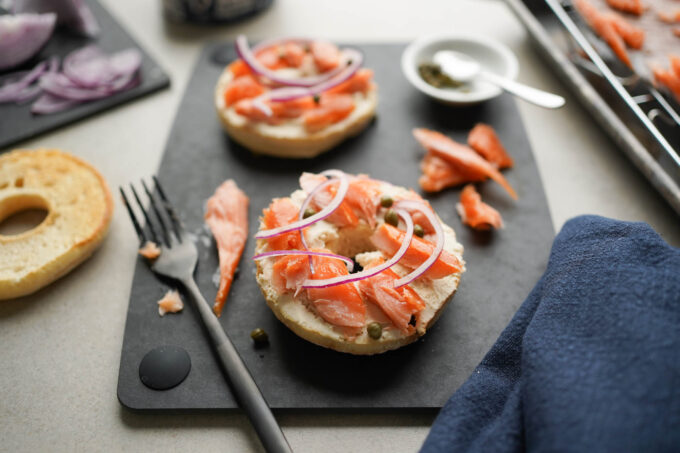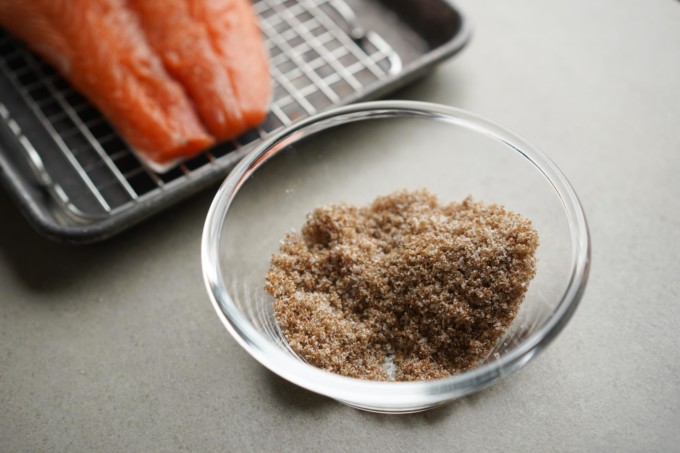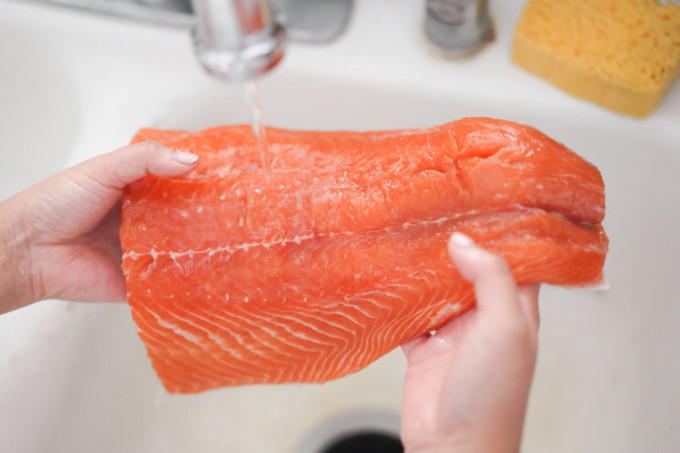This hot smoked salmon recipe will give you flaky, smoky, and slightly briny preserved fish to go with any freshly toasted bagel and cream cheese breakfast. With this recipe, you’ll learn that not all smoked salmon is the same and how to save some money at home by making your own.

Background
Historically, smoked salmon was used as a way to preserve salmon during a time of no refrigeration. When salmon is smoked, it goes through a curing process and a slight dehydration period that prevents bacteria from spoiling the food as fast as it would for fresh salmon. This type of salmon preservation was present all over the world, from Native American cuisine to Polish to Greek and more.

These days you can easily buy smoked salmon in its hot smoked or cold smoked varieties in many grocery stores like Trader Joe’s or Costco. Some popular brands and boutique smoked salmon stores are Honey Smoked Fish Co., Russ and Daughters, and Wexler’s Deli.
Hot vs cold smoked salmon
The difference between hot smoked and cold smoked salmon is the temperature at which it’s smoked. Hot smoked salmon is typically smoked at 120 °F or higher, whereas cold smoked salmon is smoked at 90 °F or below.
Since hot smoked salmon burns smoke at a higher temperature, it can have a stronger smoky flavor than its sibling. They also have textural differences; Hot smoked salmon has a flakier texture and cold smoked salmon is silkier and has a glossy sheen when you cut into it.
Type of salmon to use for smoking

There are various types of salmon that you can use to make the best smoked salmon and these days you can find different types in your local grocery store.
- Atlantic salmon: This variety of salmon is widely available and is farmed. It’s brighter orange coloring and high fat content gives your smoked salmon a stronger flavor. This variety is more affordable than other types of salmon.
- King salmon: One of the most popular varieties to smoke, King salmon has a high-fat content, deep red coloring, and extra flaky texture. It’s also known as Chinook salmon.
- Sockeye salmon: A popular variety of salmon to smoke second to King salmon. It’s got a nice balance of leanness and firmness that makes it a good candidate for hot smoking because it won’t fall apart.
How to season salmon for smoking
When brining and seasoning the salmon, you have the option of using a wet brine or a dry brine. Wet brine allows you to soak the salmon in a mixture of salty water and other seasonings. Dry brining salmon means to coat the fish with salt and other seasonings directly onto the flesh. We prefer dry brining because it’s easier, less of a mess, and can be a quicker brining process.
Why and how to form pellicle on salmon for smoking

One of the most important lessons in learning how to smoke salmon, whether it’s hot or cold smoked, is forming a pellicle on the skin after brining. A pellicle is a coating on the skin made up of proteins that help smoke adhere to the salmon during smoking.
To form a pellicle, make sure to rinse all of the brine off the salmon and pat it dry with paper towels. Add the salmon back onto the wire rack, uncovered, and let it sit in the fridge for at least four hours or until the skin has a tacky and glossy texture.
You can also keep the salmon on the counter if the room is under 65 °F and keep a fan nearby for circulation. Since we’re in Southern California and it’s difficult to reach that coolness during the warmer months, I’ve found that the fridge works fine.
Type of electric smoker we used
We used a Traeger smoker for this recipe and set it to the lowest temperature. Since the lowest setting on the Traeger is 165 °F, we make sure to check on the internal smoker temperature and internal salmon temperature every so often to make sure the salmon doesn’t overcook. We used alderwood pellets since it has a nice and mild flavor that goes really well with salmon. To learn more about what types of wood to smoke for your recipe, read more about it here.
How long to smoke salmon

The amount of time to smoke salmon has a lot of contributing factors, such as how thick the cut of salmon is, how much salmon you’re smoking, etc all affecting it.
I like to set the temperature of the smoker to the lowest setting and check every 20 minutes until I reach the desired internal temperature. I adjust the temperature of the smoker along the way. This is a similar process to smoking 3-2-1 ribs.
For a one-pound salmon, I smoke at the lowest setting for about 1 hour or until the salmon reaches an internal temperature of about 110-120 °F. Raise the temperature to one level (about 180 °F) above and continue to cook for another 15 minutes and check the internal temperature again. Once it reaches 145 °F, pull the salmon and let it rest on the counter for 15 minutes.
What temperature to smoke salmon
The lowest temperature our Traeger runs on is 165 °F, so we made sure to keep checking the internal meat temperature and smoker temperature every 20 minutes. After about one hour, raise the temperature to one level higher at about 180 °F until the salmon reaches 145 °F; This is the temperature that the salmon will finish cooking.
During the last part of smoking at a higher level, the salmon will cook faster than the previous hour of smoking. Keep track of the internal temperature and the look of the salmon. If you begin to see white spots form on the salmon but it hasn’t reached 145 °F yet, bring the temperature of the smoker down to prevent it from overcooking. These white spots are called albumin and they signal that the salmon is beginning to overcook and produce protein on the skin.
Is smoked salmon still raw?
No, reaching 145 °F internal temperature means the smoked salmon is fully cooked and no longer raw. Once the temperature of your salmon reaches 145 °F you can remove it from the smoker. Use an instant-read thermometer to check the internal temperature of the fish to make sure it’s reached this level.
What is the best way to eat smoked salmon?

Some popular ways to eat smoked salmon is on a cream cheese bagel topped with ringlets of red onion and salty capers, or on top of a fresh salad with Asian style dressing. You can even experiment by using this smoked salmon for the popular TikTok salmon rice bowls. For other salmon recipes, try broiled salmon, miso salmon, pesto salmon, and salmon poke. Other Traeger recipes I love to make during the weekends are smoked chicken thighs and smoked turkey breast.

How to Smoke Salmon – Easy Smoked Salmon Recipe
Ingredients
- 1 lb salmon filet
- 2 tbsp kosher salt
- 2 tbsp dark brown sugar
- alderwood chips or pellets or apple wood
Equipment Used
- small bowl
- paper towel
- quarter sheet pan and rack
- Foil
- smoker
Instructions
- Pat dry the salmon with a paper towel and place on a rack lined sheet pan.
- In a bowl, mix together the brown sugar and kosher salt. Lightly coat the skin side (about ¼ the amount of the brine). Thoroughly coat the meat side of the salmon with the rest of the brine. Place the salmon back onto the rack, making sure that it’s lifted from the bottom of the sheet pan. Cover with foil.
- Let sit in the fridge for 8 hours or overnight to marinate.
- Rinse off the brine with water and pat dry. Place the salmon back onto the rack uncovered.
- Place back in the fridge for at least 5 hours or until it forms the pellicle. The skin should be tacky and glossy. Remove the fish from the fridge and place it on the counter for about 30 minutes to prepare for even cooking.
- Preheat the smoker to 140-150 °F. Add the fish and close the lid.
- Check the temperature of the smoker and internal temperature of the fish every 20 minutes.
- After about 1 hour (or when the internal temperature reaches about 110-120 °F), raise the temperature to 180 °F and cook for another 15-20 minutes. Remove the fish once it reaches 145 °F.
- Let the fish rest on the counter, uncovered for about 10-15 minutes.
- Serve or cover in an airtight container in the fridge until you want to consume.














